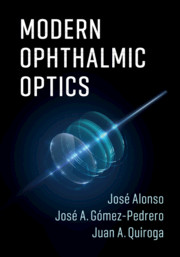Book contents
- Frontmatter
- Contents
- Foreword
- Preface
- Acknowledgements
- List of Symbols and Acronyms
- 1 Ophthalmic Materials
- 2 Surfaces in Ophthalmic Lenses
- 3 Wavefronts and Rays
- 4 Single Vision Lenses
- 5 The Lens-Eye System
- 6 Aberrations and Lens Design
- 7 Optics of Contact and Intraocular Lenses
- 8 Multifocal Lenses
- 9 Low Vision Aids and High Power Lenses
- 10 Lens Manufacturing and Measurement
- 11 Filters and Coatings
- Appendix A Frames
- Appendix B Introduction to Matrix Algebra
- Appendix C Introduction to Surface Geometry
- Appendix D Local Dioptric Power Matrix
- Appendix E Seidel Aberrations and Zernike Polynomials
- Appendix F Abelès Theory of Multilayer Films
- References
- Index
- References
References
Published online by Cambridge University Press: 25 March 2019
- Frontmatter
- Contents
- Foreword
- Preface
- Acknowledgements
- List of Symbols and Acronyms
- 1 Ophthalmic Materials
- 2 Surfaces in Ophthalmic Lenses
- 3 Wavefronts and Rays
- 4 Single Vision Lenses
- 5 The Lens-Eye System
- 6 Aberrations and Lens Design
- 7 Optics of Contact and Intraocular Lenses
- 8 Multifocal Lenses
- 9 Low Vision Aids and High Power Lenses
- 10 Lens Manufacturing and Measurement
- 11 Filters and Coatings
- Appendix A Frames
- Appendix B Introduction to Matrix Algebra
- Appendix C Introduction to Surface Geometry
- Appendix D Local Dioptric Power Matrix
- Appendix E Seidel Aberrations and Zernike Polynomials
- Appendix F Abelès Theory of Multilayer Films
- References
- Index
- References
Information
- Type
- Chapter
- Information
- Modern Ophthalmic Optics , pp. 520 - 541Publisher: Cambridge University PressPrint publication year: 2019
